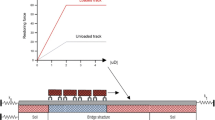Abstract
Railway bridges with a continuously welded rails are subject to track-bridge interactions due to temperature changes and train load, which cause an additional axial force on the rail. The recently developed sliding slab track can significantly reduce the axial force on the rail caused by such interactions by placing a low frictional sliding layer between the track slab and the bridge deck and separating the longitudinal movement of the bridge from that of the track. In this study, the anchor in the fixed support region, which is an important component of the sliding slab track, was analytically evaluated to derive the load–displacement relationship, and the track-bridge interaction of the continuous bridge with the sliding slab track was analyzed considering the derived relationship. The anchor was examined for the cases of infinite stiffness, consistent stiffness, and damaged state; the stiffness of the anchor reached 10% of the original. There were no significant differences in the rail stress, track slab axial force, and rail displacement when the stiffness of the anchor was interpreted as infinite. Although the displacement of the rail increased when the anchor was damaged, there was no significant increase in the rail stress or the track slab axial force. It was confirmed, however, that the damaged anchor must be repaired as early as possible because the damage can develop rapidly as the displacement of the damaged anchor significantly increases.















Similar content being viewed by others
Abbreviations
- \(c\) :
-
Length of crushed concrete zone
- \(d_{b}\) :
-
Diameter of dowel rebar
- \(D\) :
-
Dowel force
- \(D_{u}\) :
-
Maximum Dowel force
- \(E_{s}\) :
-
Dowel bar modulus of elasticity
- \(f_{b}\) :
-
Concrete bearing strength
- \(f_{c}^{'}\) :
-
Concrete compressive strength
- \(f_{y}\) :
-
Yield strength of dowel rebar
- F s :
-
Frictional force of sliding layer
- \(K_{f}\) :
-
Concrete foundation modulus (271.7 MPa/mm)
- N :
-
Normal force
- \(S\) :
-
Dowel deflection
- \(S_{u}\) :
-
Dowel deflection at \(D_{u}\)
- \(T\) :
-
Dowel bar axial force
- \(T_{y}\) :
-
Dowel bar yield axial force
- W rail :
-
Unit weight of two pieces of 60E1 rail
- W slab :
-
Unit weight of concrete track slab
- W trian :
-
Unit weight of train
- \(\alpha\) :
-
Inclination angle of dowel bar
- μ :
-
Frictional coefficient of sliding layer
References
International Union of Railways (UIC). (2001). UIC Code 774-3R: Track/bridge Interaction Recommendations for Calculations (2nd ed.). Paris: International Union of Railways.
Kim, T. G., Jung, D. K., & Lee, K. C. (2017). Experimental study of low-frictional behavior for sliding slab track. Journal of the Korean Society for Railway,20, 241–247. (in Korean).
Korea Rail Network Authority. (2014). Track-bridge longitudinal interaction, KR C-08080. (in Korean).
Lee, K. C., Jang, S. Y., Jung, D. K., & Byun, H. (2015). Evaluation of stress reduction of continuous welded rail of sliding slab track from track–bridge interaction analysis. Journal of the Korean Society of Civil Engineers,35, 1179–1189. (in Korean).
Lee, K. C., Jang, S. Y., & Lee, J. (2017). Development of sliding slab track to reduce track–bridge interaction. In Proceeding of the 2017 first international conference on rail transportation, Chengdu, China.
Lee, K. C., Jang, S. Y., Lee, J., & Choi, H. (2016). Comparative analysis of track–bridge interaction of sliding slab track and rail expansion joint for long-span railway bridge. Journal of the Computational Structural Engineering Institute of Korea,29, 169–177.
Lee, S. C., Park, S., Lee, J., & Lee, K. C. (2018). Dowel behavior of rebars in small concrete block for sliding slab track on railway bridges. Advances in Materials Science and Engineering. https://doi.org/10.1155/2018/3182419.
Manovachirasan, A., Suthasupradit, S., Choi, J. K., Kim, B. J., & Kim, K. D. (2018). The evaluation of axial stress in continuous welded rails via three-dimensional bridge–track interaction. International Journal of Steel Structures,18(5), 1617–1630.
Randl, N. (2007) Load bearing of cast-in shear dowels. Ernst & Sohn Verlag fur Architektur and technische Wissenschaften GmbH & Co. KG, Berlin, Beton- und Stahlbetonbau; 102, Special Edition: 31–37.
Ren JJ and Liu X. (2010) Occasional forces and displacements of longitudinally coupled ballastless jointless turnout on bridges. J Southwest Jiaotong Univ; 18(1), Article ID 1005-2429(2010)01-0001-07.
Ren, J. J., Liu, X., & Xiang, R. (2010) Force characteristics of longitudinally coupled slab track turnout on bridges under temperature action. In Transport Res Record: J Transport Res Board, No. 2159 (pp. 85–90). Washington, DC: Transportation Research Board of the National Academies. https://doi.org/10.3141/2159-11.
Sanguino, M. C., & Requejo, P. G. (2009). (2009) Numerical methods for the analysis of longitudinal interaction between track and structure. In R. Calçada, R. Delgado, A. C. Matos, J. M. Goicolea, & F. Gabaldón (Eds.), Track–bridge interaction on high-speed railways (pp. 95–108). London, UK: Taylor & Francis Group.
Soroushian, P., Obaseki, K., Rojas, M. C., et al. (1986). Analysis of dowel bars acting against concrete core. ACI Journal Proceedings,83, 642–649.
Soroushian, P., Obaseki, K., Rojas, M. C., et al. (1987). Behavior of bars in dowel action against concrete cover. ACI Journal Proceedings,84, 170–176.
Wang, P., Ren, J. J., Xiang, R., & Liu, X. Y. (2012). Influence of rub-plate length on forces and displacements of longitudinally coupled slab track for a bridge turnout. Proceedings of the Institution of Mechanical Engineers, Part F: Journal of Rail and Rapid Transit,2012, 284–293. https://doi.org/10.1177/0954409711420776.
Acknowledgements
This research was supported by a Grant (17RTRP-B071566-05) from Railroad Technology Research Program funded by Ministry of Land, Infrastructure and Transport of the Korean government and supported by Korea Railroad Research Institute.
Author information
Authors and Affiliations
Corresponding author
Additional information
Publisher's Note
Springer Nature remains neutral with regard to jurisdictional claims in published maps and institutional affiliations.
Rights and permissions
About this article
Cite this article
Choi, H.S., Lee, KC., Lee, SC. et al. Interaction Analysis of Sliding Slab Track on Railway Bridge Considering Behavior of End-Supporting Anchors. Int J Steel Struct 19, 1939–1950 (2019). https://doi.org/10.1007/s13296-019-00255-x
Received:
Accepted:
Published:
Issue Date:
DOI: https://doi.org/10.1007/s13296-019-00255-x




